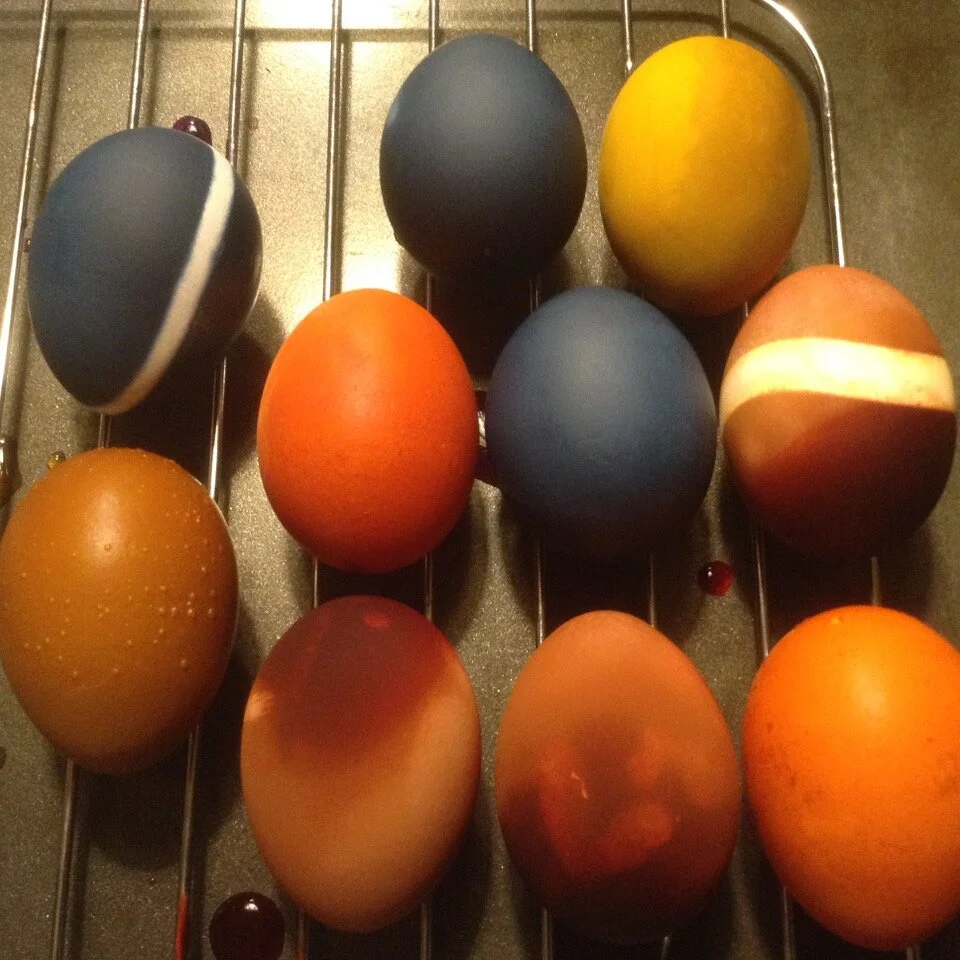Egg Dyeing - Naturally
Your kitchen is full of natural dyes. Common food items such as red cabbage, onion skins, and coffee can be used to transform plain white eggs into colourful Easter gems. Kids will especially love discovering all the different colours they can create—let them experiment using hard-boiled eggs and bowls of cold dyes. The final result nearly looks like stone!
Materials: natural dyeing agents (red cabbage, turmeric, onion skins, beets, and coffee); eggs; three-quart pots (or larger); white vinegar; strainer; small bowls; large metal spoon; paper towels; drying rack
Dye Recipes
Select a dyeing agent, and place it in the pot using the amount listed below. Add 1 quart of water and 2 tablespoons white vinegar to pot; if more water is necessary to cover ingredients, proportionally increase the amount of vinegar. Bring to a boil, and lower heat. Allow the ingredients to simmer for 30 minutes. Strain dye into a bowl, and let cool.
• Red-cabbage dye: 4 cups chopped cabbage
• Turmeric dye: 3 tablespoons turmeric
• Onion-skin dye: 4 cups onion skins (skins of about 12 onions)
• Beet dye: 4 cups chopped beets
• Coffee dye: 1 quart strong black coffee (instead of water)
Cold Dipping Method
With this method, the eggs and the ingredients for the dye are boiled separately. Using a metal spoon, lower cooled hard-boiled eggs into a bowl of dye, and let them soak for as little as 5 seconds or as long as overnight, depending on the depth of colour you desire. Remove eggs with spoon, pat dry with paper towels, and let dry on a wire rack. The cold-dipping method produces subtle, translucent shades, but can result in an uneven colour unless the eggs are rotated vigilantly while in the dye. For hollow eggs that will last indefinitely, cold-dip raw eggs, then blow them out after they are dyed.
Boiled Method
This method involves boiling the eggs with the dye; the heat allows the dye to saturate the shells,
resulting in intense, uniform colours. Set raw eggs in a pot of strained dye; bring to a boil for the
amount of time specified in our colour glossary. Remove and dry eggs as with the cold-dipping method.
COLOUR GLOSSARY
Natural dyes can sometimes produce unexpected results, so don’t be surprised if, for example, your
red-cabbage dye yields blue eggs. Use the following guide to help you achieve the colours you desire.
Deep Gold: Boil eggs in turmeric solution, 30 minutes.
Sienna: Boil eggs in onion-skin solution, 30 minutes.
Dark, Rich Brown: Boil eggs in black coffee, 30 minutes.
Pale Yellow: Soak eggs in room-temperature turmeric solution, 30 minutes.
Orange: Soak eggs in room-temperature onion-skin solution, 30 minutes.
Light Brown: Soak eggs in room-temperature black coffee, 30 minutes.
Light Pink: Soak eggs in room-temperature beet solution, 30 minutes.
Light Blue: Soak eggs in room-temperature cabbage solution, 30 minutes.
Royal Blue: Soak eggs in room-temperature cabbage solution overnight.
Lavender: Soak eggs in room-temperature turmeric solution, 30 minutes. Follow with room-temperature cabbage solution, 30 seconds.
Chartreuse: Soak eggs in room-temperature turmeric solution, 30 minutes. Follow with room-
temperature beet solution, 5 seconds.
Salmon: Soak eggs in room-temperature turmeric solution, 30 minutes. Follow with room-temperature beet solution, 30 minutes.
Source: www.marthastewart.com
Have fun!
Shelby's Notes
- for greater intensity of colour: cold soak overnight
- coffee simply results in a brown egg, but it's nice to use in combination with other colours
- for the striping effect: allow colour to dry, wrap with elastic band, immerse in new colour(s)




